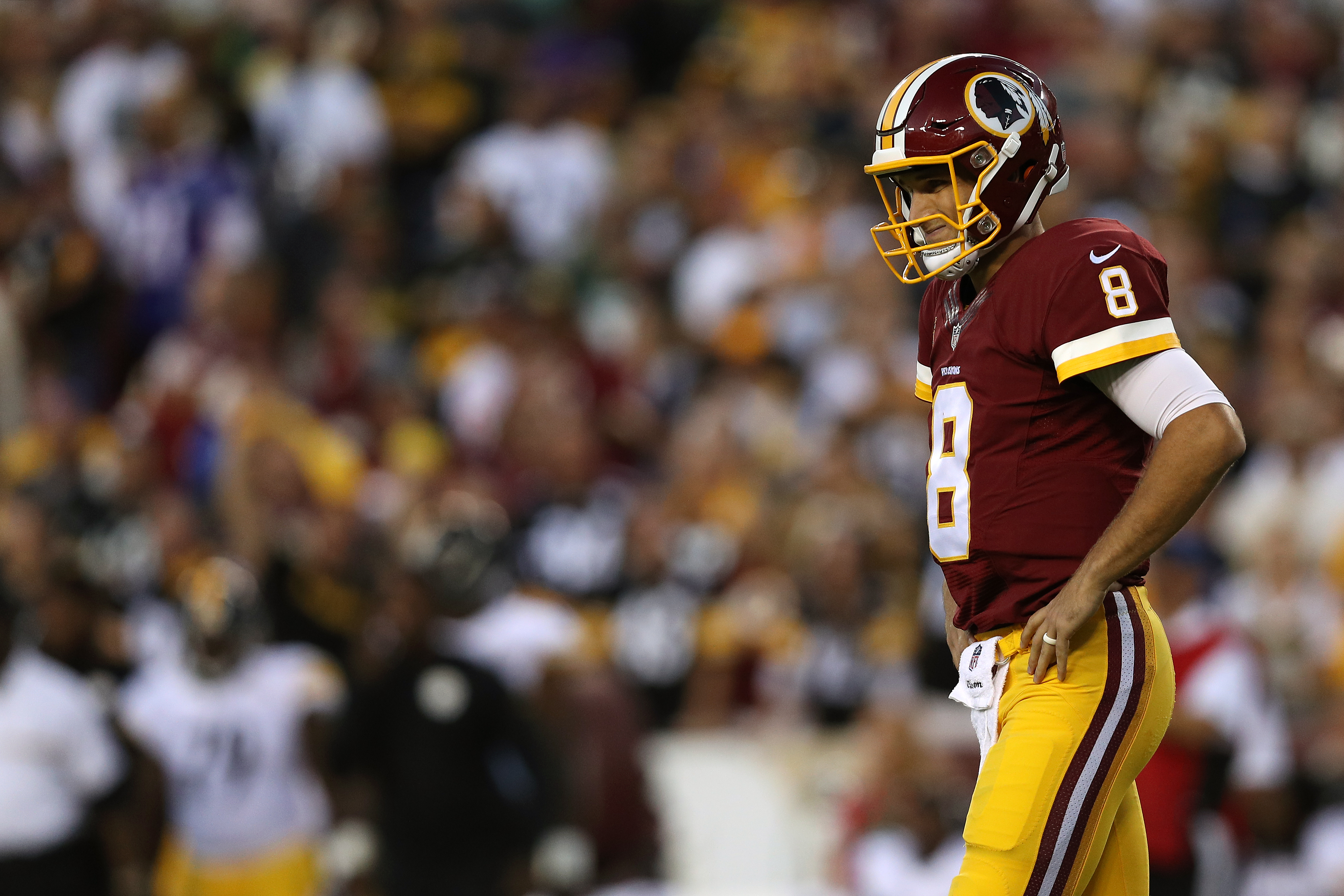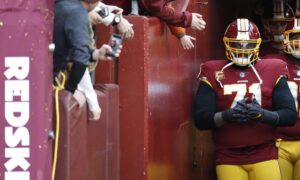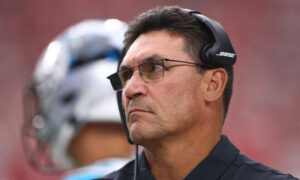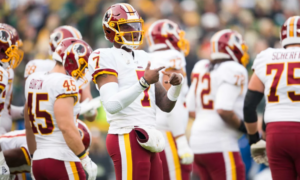The uncertainty surrounding Quarterback Kirk Cousins and his future with the Washington Redskins will become at least somewhat more clear this week; the franchise tag can be applied to him no later than 4pm on Wednesday March 1st.
All current indicators from both the team and player side of this protracted negotiation process heavily suggest that the franchise tag will be applied and Cousins will sign it quickly. Cousins’ agent Mike McCartney will aim to ensure that subsequent negotiations focused on a long-term deal will use the tag as a foundation upon which to build the financial structure necessary to convince Cousins to sign.
Inside Redskins park, it is understood that President Bruce Allen and Vice President of Football Administration Eric Schaffer are generally aware of the price and structure that Cousins is looking for in a long term deal, even though formal negotiations have not yet commenced. Unlike in 2016 when the Redskins opening offer to Cousins was about $3.5 million dollars per year less than the price of the franchise tag, this year the Cousins camp knows that the Redskins will be coming to the table with a fair and generous offer. However, they also know it’s unlikely to be the biggest offer financially that they’d get if Cousins was on the open market, and that’s where things get interesting.
If the Redskins stand firm and are unable to reach an agreement with Cousins and McCartney on what both parties consider the right price point for a long term deal, then the Redskins will quickly find themselves in uncharted waters; a Quarterback on the 2017 books for $23.94 million dollars, whom has no ascertainable future with the organization.
From the outside it will look as if the Redskins brass are being overly stingy when it comes to negotiating a new contract with the statistically best Quarterback the franchise has ever had. The real story, however, will be that the Redskins will have offered Cousins a deal that would see him become a top-five highest paid player at his position in the NFL, and would potentially include the highest amount of guaranteed money ever seen. If after presenting Cousins with such an offer a deal still cannot be reached, then it will be rightly seen as an indication that Cousins wants out.
Suddenly, trading Kirk Cousins becomes not only viable, but perhaps the most sensible option available.
Unfortunately for Redskins fans with pie-in-the-sky dreams of eliciting a huge haul in return for Kirk Cousins, the painful reality is that if the Redskins do sell Cousins, they won’t be selling high. The thirty one other teams across the NFL will know without doubt that if the Redskins are selling Cousins in the 2017 offseason, it’s because the Redskins know he won’t be on the team in 2018. That immediately undercuts the negotiating position for Washington, and means that Bruce Allen will need to do his best job at convincing buyers that they’re getting the deal of a lifetime. Further complicating the value of Cousins on the trade market is the enormous financial cost he’ll place on any team he lands on. It doesn’t matter where Cousins plays; he will insist upon being paid in excess of $24 million dollars per year for at least four years. That’s huge money.
The last time a starting Quarterback was traded saw Sam Bradford traded from Philadelphia to Minnesota in exchange for a 1st and 4th round draft pick. Universally it is acknowledged that the Vikings overpaid, but this was a result of their desperation to not have a lost-season following the devastating injury to Teddy Bridgewater.
Cousins is, across almost every conceivable metric, a more attractive Quarterback than Sam Bradford, so it is natural that fans and neutral observers alike would expect his price in a trade to be equal or higher than Bradford’s. The reality of the situation suggests that this may not be the case though, as Cousins trade value is not going to be solely based on a reflection of his playing ability.
Here are three hypothetical trades that match what the expected trade market for Kirk Cousins could look like.
Trade One
San Francisco receives
QB Kirk Cousins
Washington’s 2017 1st round pick (17 overall)
Washington receives
San Francisco’s 2017 1st round pick (2 overall)
San Francisco’s 2018 3rd round pick (Conditionally upgraded to 2nd round pick if Cousins starts 14 games in 2017)
Analysis: This is, roughly, the trade that many pundits have previously speculated as possible should the Niners and Kyle Shanahan decide to pull the trigger and attempt to buy Kirk Cousins. Moving down from #2 overall to #17 is a significant downgrade, especially in a draft class that appears to have a reasonably significant drop-off in talent outside of the top eight picks. By adding in a 2018 3rd round pick that is potentially (and likely) upgraded conditionally to a 2nd round pick will give Scot McCloughan more ammunition to play with in 2018, noting that the Redskins already hold nine picks in this years draft.
Trade Two
San Francisco receives
QB Kirk Cousins
Washington receives
San Francisco’s 2017 2nd round pick (34 overall)
San Francisco’s 2017 3rd round pick (66 overall)
San Francisco’s 2018 2nd round pick
Analysis: Washington doesn’t get the valuable 2nd overall pick in this years draft, but also doesn’t need to send away their own 1st round pick either. For the Niners, they get their new Quarterback without giving up a first round pick, but that doesn’t mean they’ve under-paid; two second round picks and a 3rd round pick for a team with significant holes to fill is still a high price to pay. McCloughan will end up with three top 50 picks in 2017, giving him plenty of chances to add new talent, or flexibility to move laterally throughout the draft.
Trade Three:
Cleveland receives
QB Kirk Cousins
Washington receives
Cleveland’s 2017 1st round pick (12 overall, from Philadelphia)
Analysis: Given that they are picking #1 overall, Cleveland has room to move in terms of their second pick in the first round of the draft. The Redskins would suddenly find themselves picking twice in close succession at 12 and 17, and it gives McCloughan much desired flexibility to truly draft ‘best available’ despite the clear needs on the defensive side of the ball; suddenly taking a ‘luxury’ pick at Running Back or Receiver is more palatable if you’re also adding in a prodigious first round defensive talent at the same time. Spare a thought for Robert Griffin III, who would face the humiliation of losing his job to Kirk Cousins twice in as many years.
If the negotiations with Kirk Cousins do break down and the Redskins attempt to move him in a trade, don’t expect McCloughan to panic and draft a Quarterback in the first round. It is far more likely that McCloughan would stick to his guns and take the best available players, and the 2017 Quarterback class, frankly speaking, looks average at best. Accordingly, look for McCloughan to take a look at mid-round prospects like Davis Webb (Cal) or Nate Peterman (Pitt).
What do you think? Which of these three potential trades would you be most satisfied with? Or do you find all three unpalatable? Let us know in the comments below, or hit us up on Twitter!
Comments
Powered by Facebook Comments
























